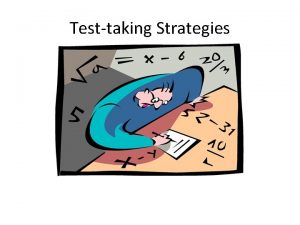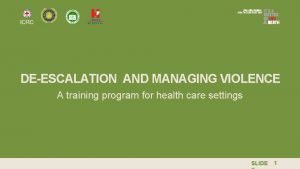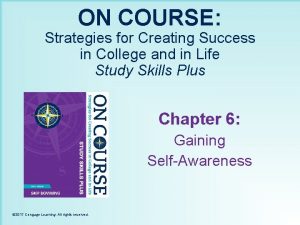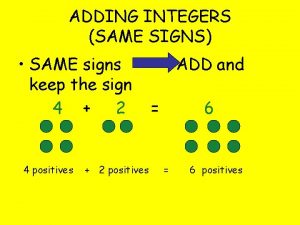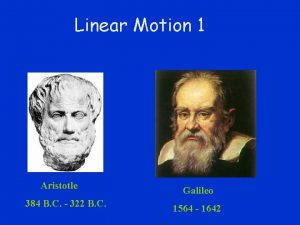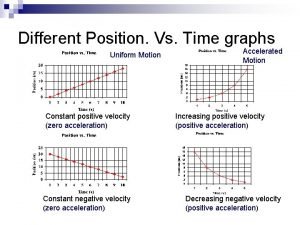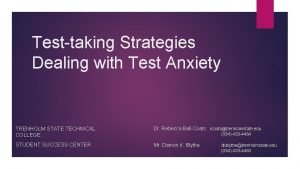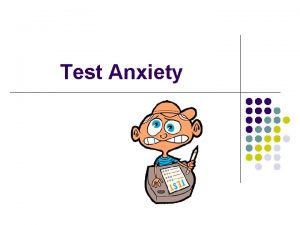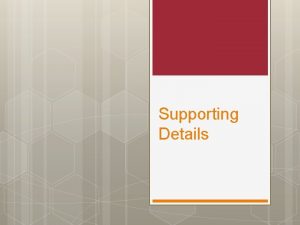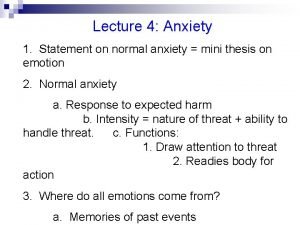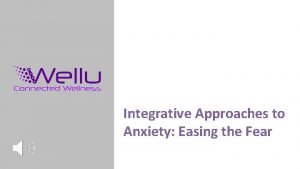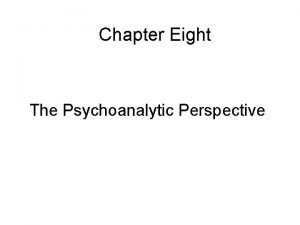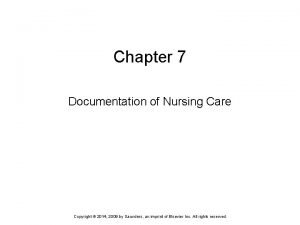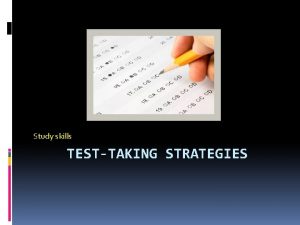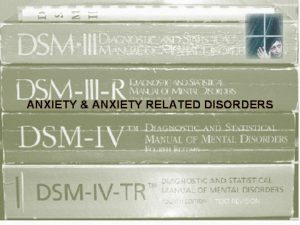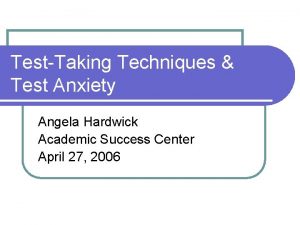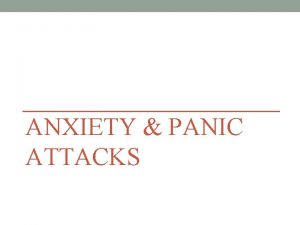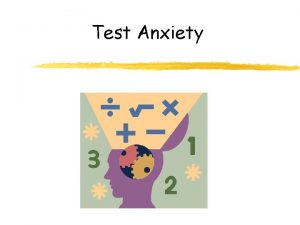Testtaking Strategies Success Reduce Anxiety Challenge negative thoughts











































- Slides: 43

Test-taking Strategies Success!!

Reduce Anxiety Challenge negative thoughts Controlled breathing Desensitize yourself to the fear response Muscle relaxation Imagery Over prepare Exercise

Test Prep… the most important step Read the material prior to lecture Ø Tape lecture – listen and Ø Ø This is essential to know what the instructor is going to talk about Star concepts on power points you don’t understand for further study Listen to taped lecture with open book and class notes Flag or Tab your notes – stay organized

continued Organize study with pathophysiology of disease/system Signs and symptoms (including labs) Nursing Diagnosis Goals Specific Implementation plans Patient teaching

Techniques Concentrate on the simple before the complex. Make educated guesses. Ø Never leave a question blank. Maintain a positive attitude. Check your answers and answer sheets.

The Multiple Choice Question Has 2 parts 1 st part: stem – the statement that asks a question. Ø 2 parts: 1) information about a clinical event, topic, concept, or theory; 2) asks for a response 2 nd part: possible responses called options

Information part – bold response part - italicized When walking, a patient becomes weak and the patient’s knees begin to buckle. What should the nurse do? Which is an example of a patient goal? Before administering medication for pain, what should the nurse do first?

When reading the stem: Underline the important words Do not add information from your own mind Do not make assumptions (read between the lines) about the information present in the stem

When reading the options: Read all the options before choosing the correct answer Refer back only to the words that you underlines as being important in the stem Do not add information to an option Relate an option to just what is being asked in the response part of the stem Do not focus only on your experiences, which may be too narrow for a point of reference

RACE MODEL Recognize Ask Critically analyze Eliminate

RACE MODEL RECOGNIZE Ø what information is in the stem. Recognize key words in the stem. q Recognize who the client is in the stem. q Recognize what the topic is about. q

RACE MODEL ASK what is the question asking? q Ask what are the key words in the stem that indicate the need for a response. q Ask what the question is asking me to do. Ø

RACE MODEL CRITICALLY Ø analyze the options in relation to the question asked in the stem. Critically scrutinize each option in relation to the information in the stem. q Critically identify a rationale for each option. q Critically compare and contrast the option in relation to the information in the stem and their relationships to one another q

RACE MODEL ELIMINATE Ø as many options as possible. Eliminate one option at a time. q If any part of the distracter is wrong it is all wrong. q

RULES FOR TEST TAKING Suggestions for success

Rule #1 Know the parts of a test question. Ø Multiple choice questions. Item: the entire question Stem: the statement that asks the question Options: possible responses Ø Options: one is correct, the remaining are distracters. Part of the distracters may be correct.

Rule #2 Read the question carefully before looking at the options: Ø Identify Key Words in the Stem

Sample (Stem) Mr. Jones blood pressure is 240/120. The nurse would recognize he is: A. hypertensive B. hypotensive C. normal D. likely to have orthostatic hypotension

Rule #3 Identify the Theme of the Item, and base it on information provided in the stem. Don’t assume information that is not given.

Rule #4 Answer difficult questions by eliminating the obviously incorrect responses first; Select the BEST of the remaining options. Ø Cross out incorrect pieces of the distracters Ø Write rationales

Rule #5 Select Responses that are: Ø Ø Ø Therapeutic Show respect Communicate acceptance Eliminate Responses that: Ø Ø Ø Are bizarre Inappropriate Punitive

Rule #6 Know the Basic Principles that Guide the practice of Nursing Process Ø Maslow’s Hierarchy Ø Ø Assessment, analysis/Nursing Diagnosis, Planning, Implementation, Evaluation Physiological needs first: Airway, Breathing, Circulation, Disability Safety second Prioritization

Rule #7 Look for patterns in Your Performance and Flaws in Your Thinking. Analyze your test-taking behaviors, then establish strategies to correct these problem.

Common Errors Did not recognize or remember information Did not understand subject matter Did not recognize item idea Did not recognize principle or rationale for correct answer Missed key word

continued Did not read all distracters carefully Did not understand question Read into question Used incorrect rationale for selecting response Changed the answer

Rule #8 Manage your time effectively during Testtaking.

Rule #9 Do not change answers without Ø Ø Good reason Sound rationale

Rule #10 Choose options that are within the realm of nursing. Ø Be able to differentiate the need for nursing judgment from the need for physician judgment.

Techniques Identify key words in the stem that indicate negative polarity: except, not, never, contraindicated, unacceptable, least, avoid Identify key words in the stem that set a priority: best, first

continues Identify clues in the stem (extra explanations) Identify patient-centered options Identify specific determiners in options (increased in 2 options, decreased in 2 options)

Some Words to Know erroneously contraindicate violate ensure rationale mandatory appropriate indicate anticipate strategies perception determine disrupted reveal

SPECIFIC TEST-TAKING TECHNIQUES Identify opposites in options (hypotensive, hypertensive) Identify equally plausible or unique options Identify duplicate facts in the options (some options have one part that is true and another that is false) IF ANY PART IS WRONG IT IS ALL WRONG!!!!!!

continued Identify options that Ø Ø Ø deny patient feelings, concerns needs Use multiple test-taking techniques

COGNITIVE LEVELS OF NURSING QUESTIONS KNOWLEDGE ØCOMPREHENSION ØAPPLICATION ØANALYSIS Ø

KNOWLEDGE QUESTIONS Require you to recall and/or remember

What is the normal range of a radial pulse in an adult ? a. 50 to 65 b. 70 to 85 c. 90 to 105 d. 110 to 125 to answer this question correctly, you have to know the normal range of a radial pulse

COMPRENHENSIVE QUESTIONS Require you to understand information

Which of the following demonstrates wheelchair safety? a. pushes the client face forward, ahead of him into the elevator b. raises the footplate before transferring the client into the wheelchair c. positions the client as far forward as possible in the wheelchair seat d. positions the chair ahead of him when going down an inclined ramp

APPLICATION QUESTIONS Require you to use information

To prevent self-injury when lifting a heavy patient higher in bed, the nurse should: a. b. c. d. keep the knees and ankles straight strengthen the knees and bend at the waist place the feet together with the knees bent position the feet apart with one placed forward

ANALYSIS QUESTIONS Require you to interpret a variety of data and recognize the commonalties, differences and interrelationships among presented ideas

A patient has dependent edema of the ankles and feet and is overweight. Which diet should the nurse expect the doctor to order? a. low salt and high in fat b. low in salt and low in calories c. high in salt and high in protein d. high in salt and low in carbohydrates

You Can Do It! HAVE CONFIDENCE KNOW THAT YOU CAN BE SUCCESSFUL Ø YOU MADE IT THIS FAR. RELAX ASK FOR ASSISTANCE WHEN YOU NEED IT AND SOMETIMES WHEN YOU DON’T.
 Testtaking
Testtaking I am not my thoughts
I am not my thoughts Your child's success or lack of success
Your child's success or lack of success Your child's success or lack of success
Your child's success or lack of success Teen challenge nottingham
Teen challenge nottingham Examples of changing negative thoughts to positive
Examples of changing negative thoughts to positive Negative thoughts
Negative thoughts Inner defender and inner guide examples
Inner defender and inner guide examples On course strategies for creating success in college
On course strategies for creating success in college Negative numbers success criteria
Negative numbers success criteria When the signs are the same and keep the sign
When the signs are the same and keep the sign Negative velocity negative acceleration
Negative velocity negative acceleration Tvtat
Tvtat How anxiety affects eyewitness testimony
How anxiety affects eyewitness testimony Relaxation techniques test anxiety
Relaxation techniques test anxiety Anxiety symptoms
Anxiety symptoms I'm a perfect example of someone who has math anxiety
I'm a perfect example of someone who has math anxiety Neurotic behavior
Neurotic behavior Define neurotic
Define neurotic Nursing interventions for powerlessness
Nursing interventions for powerlessness Examples of generalized anxiety disorder
Examples of generalized anxiety disorder Chapter 8 managing stress and anxiety
Chapter 8 managing stress and anxiety Free floating anxiety
Free floating anxiety Ego syntonic vs dystonic
Ego syntonic vs dystonic Uw integrative medicine
Uw integrative medicine Examples of generalized anxiety disorder
Examples of generalized anxiety disorder Frustration anxiety and tension
Frustration anxiety and tension Mecbal
Mecbal Generalized anxiety disorder dsm 5
Generalized anxiety disorder dsm 5 Freudian slip meaning
Freudian slip meaning Neurotic anxiety example
Neurotic anxiety example Pie nursing documentation example
Pie nursing documentation example Test anxiety essay
Test anxiety essay Chapter 18 managing anxiety
Chapter 18 managing anxiety Chapter 15 anxiety and obsessive-compulsive disorders
Chapter 15 anxiety and obsessive-compulsive disorders Caregiver anxiety
Caregiver anxiety Dr fayad
Dr fayad Coping cat fear ladder
Coping cat fear ladder Ocd behaviors
Ocd behaviors Splitting defense mechanism example
Splitting defense mechanism example Apprehensive vs anxious
Apprehensive vs anxious Anxiety disorders def
Anxiety disorders def Generalized anxiety disorder dsm 5
Generalized anxiety disorder dsm 5 Agoraphobia vs social phobia
Agoraphobia vs social phobia
